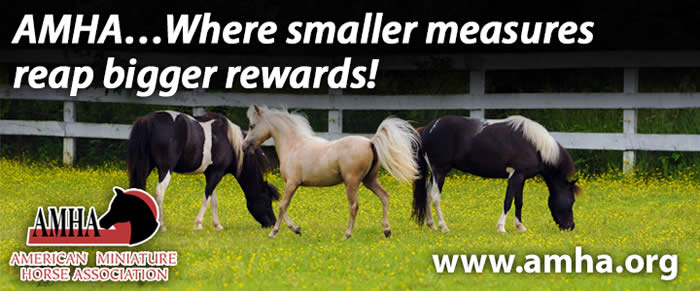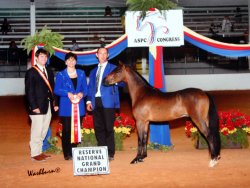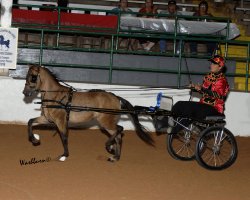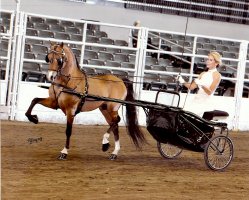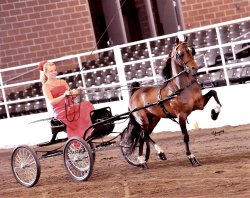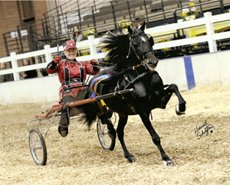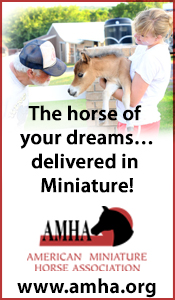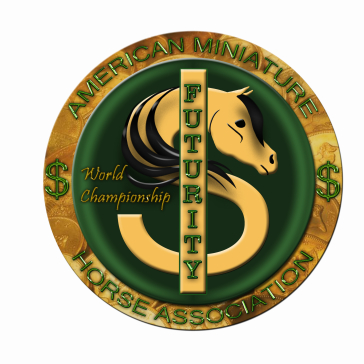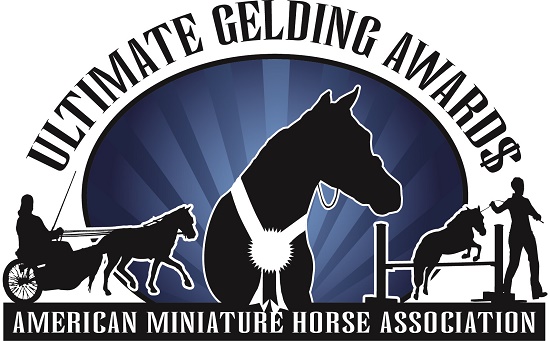Meet our Miniature Horse Registries
American Miniature Horse Registry - AMHR (info taken from www.shetlandminiature.com website) The American Miniature Horse … Unique … Interesting … A Class All of Its Own! The AMHR Miniature Horse is one of the most interesting and unique equine in existence. Although their actual history is sometimes debated, the American Miniature Horse developed right along with the 20th century. By the mid 1950s, many pony farms were raising diminutive horses for fun. By the early 1970s, the American Miniature Horse Registry was created by the American Shetland Pony Club, Inc., to serve the needs of this growing area of equine interest. Today, the Miniature Horse is a popular, versatile, well-respected and much-loved animal. Miniature Horses are bred for superb conformation and outstanding dispositions. The result is a beautifully proportionate little horse that is suitable to a variety of uses. Miniature Horses require similar care to their full-sized counterparts, but based on their size, Minis require much less space which helps make them more accessible to more people. Dwindling land resources have also contributed to the Miniature Horses’ growing popularity. The American Miniature Horse Registry is the original registry for the Miniature Horse in the United States, and it registers as many as 10,000 horses each year. It recognizes two size divisions, making AMHR the most comprehensive small equine option. Division “A” Miniatures are up to 34” in height while Division “B” Miniatures are between 34”and 38” tall. Unlike the majority of most equine breeds, Miniatures are measured at the last hair of their mane rather than at their wither. Miniature Horses come in a full spectrum of coat colorings and patterns. Unlike Shetlands, a spotted appaloosa is an accepted and popular coloring in the American Miniature Horse Registry. |
ASPC - American Shetland Pony Club (Types of Shetland Ponies and descriptions) Foundation Shetland Pony Written by Foundation Committee
The Foundation Shetland Division was founded by ASPC Members wanting to preserve the type of pony shown in the glory days of the 1950s. Many of us recall the fancy little chunky Shetland parading through the state fairs and backyards across America in those years...and many of us got our start with those ponies. The pony of the 1950s was not exactly what stepped off the boats from the Shetland Islands but rather a lovely blend of individuals selectively bred from those original imports that went on to become a household word in America. 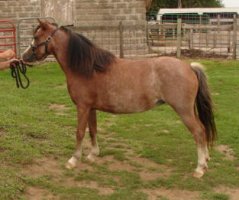
In comparison to the Classic Shetland the foundation type pony is smaller, bigger bodied, and heavier boned. They have shorter as well as thicker necks than the Classic Shetland. They are shorter legged by proportion as well. A pretty head with small ears and large expressive eyes exemplify foundation pony qualities breeders aspire to. For show purposes they may not measure over 42" inches and must be Foundation Certified. Eligible animals are issued a seal on their registration certificates, along with a special Foundation Number. They can however, stand taller than 42" inches for breeding purposes. Foundation Shetlands are shown in as natural a state as possible. While they are clipped, clean and polished; artificial appliances are not allowed. They are versatile, useful and appreciated by breeders and owners who take special pride in preservation of the Golden Era Shetland. Classic Shetland Pony Beauty … Conformation … Versatility … Substance … Style. The Classic American Shetland embodies all of these qualities and more! Classics (as Classic American Shetlands are often called) carry the ageless beauty and grace of a time-honored and well-crafted breed. Their heritage spans three centuries while their future is unlimited. The vaunted history of ASPC and its ponies date back to the 1800s when Shetlands were first imported into the United States from the Shetland Isles. From the very beginning, those Shetlands were selectively bred to improve the pony and create a truly American breed.
Today’s Classic American Shetland is a testament to the look, conformation and style honed in the American Shetland since those first days. In general, Classic American Shetland Ponies are a refined version of both the British Shetland and their early American ancestors. With well-planned selective breeding and cultivation for more than 120 years, the result is an appealing pony that continues to grow in popularity. This breed is often regarded for their outstanding toplines, well-made bodies and refinement about the ears, head and throatlatch. Classics will generally have more substance than the ultra-refined Modern and less animation. Still, Classics are never coarse, are usually exceptionally conformed and should move with beauty and style. Short, sharp erect ears, prominent eyes and a refined jaw all contribute to the Classic Shetland’s allure. Today, both stately, solid-colored Shetlands and flashy, spotted animals are both popular. Shetlands can be any color except appaloosa. No American Shetland should exceed 46” at the withers, and Classics may fall well below this maximum. Early in their history, American Shetlands sometimes matured under the 38” height limit of today’s Miniature Horse and many continue to do so presently. At ASPC-rated shows, height divisions are offered to allow for appropriate competition. By nature, the Classic American Shetland is often docile with a pleasing personality. Because of this temperament, these elegant but sturdy ponies are extremely versatile. Classics can be found in almost every equine role from pet to children’s leadline and riding mounts to school ponies to driving teams with four or more ponies up. They have been used successfully in therapeutic programs for the physically and mentally challenged as well. Of course, American Shetlands are equally at home in the show ring, dazzling along parade routes or just relaxing in their home pasture. Larger Classics approaching the 46” limit are the perfect-sized starter pony for children. From their early history of pulling ore carts in coalmines, Shetlands have retained an innate driving ability, and their popularity as a driving pony for children and adults alike continues to expand - for pleasure at home, in the show ring or in competitive driving events. In ASPC rated shows, you will see Classic American Shetlands compete at halter and under saddle. In harness, they show in pleasure driving and roadster as well as in draft hitches. They can excel in halter obstacle and are great fun in costume classes. Whatever the challenge, the ever-appealing Classic Shetland Pony is ready to shine. While these ponies are hardy and require the same general health care as a larger horse, their feed and stabling requirements are in proportionately smaller amounts. Owning a Classic Shetland does not require expensive equipment; your equipment can range from the barest essentials such as adequate space, shelter and nutrition coupled with simple grooming tools and a halter to a bridle and saddle to the harness equipment necessary for a hitch of multiple ponies or the elegance of an antique carriage. With Classics and your own personal approach, you always have choices! Today’s Classic American Shetland is a versatile pony with the temperament and personality to become a lifelong friend. For that reason, along with their beauty and their unique and long history, the Classic division is growing in popularity and will undoubtedly continue to flourish as more people meet this versatile and beautiful pony. Modern Pleasure Pony Modern Pleasure … Pretty Is as Pretty Does
Although the pleasure division itself is one of the ASPC’s newer divisions, it’s built around a long-standing tradition of pleasure driving animals that have been found in many society show horse breeds. A Modern Pleasure Shetland might be just the pony for those interested in the style and pizzazz of a Modern but who might be intimidated by the care, training and shoeing required for ponies in that division. A Modern Pleasure Pony should be pretty, well-balanced and animated with an emphasis on excellent manners. Ponies in this division must be well behaved and manners are a key component for Modern Pleasure American Shetlands. 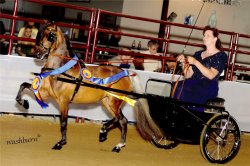
When pleasure first made its debut in the American Shetland Pony Club, it was limited to a single pleasure driving class. Today, following the creation of the Modern Pleasure division, there are many, many options for showing these types of American Shetlands. First, Modern Pleasure offers a full complement of halter and breeding classes. Additionally, there are many driving classes. For several years, the Modern Pleasure division featured two separate driving divisions: Formal and Country. Formal Pleasure was for a more animated pony with more extreme carriage while Country featured a more balanced approach to headset and less extreme animation. Ponies in both divisions must be willing and have good manners. Pleasure ponies, regardless of the division, should be a pleasure to watch and to drive. Recently, the Modern Pleasure committee recommended that the “formal” division be moved back into the Modern division since ponies competing in area often exhibit more animation and brilliance along with displaying higher headsets and more extreme carriage. Modern Pleasure Halter and the Country Pleasure division are being maintained under the Modern Pleasure umbrella. Originally, the committee’s proposal was to create another driving option within the Pleasure division so that Modern Pleasure fans would continue to have two driving options under the auspices of “Modern Pleasure” in addition to the separate formal driving pleasure option under Modern open. Plans for all changes are still being fleshed out and will be dependent on future approval and acceptance by the association’s members and national board. Modern Shetland PonyAthletic … Graceful … Animated… Spirited… Thrilling …Sophisticated described the Modern American Shetland Pony.
The American Shetland Pony is distinctly an American breed, and Modern Shetlands, with their refinement, animation and carriage, are the very essence of the goal some American Shetland breeders set more than 100 years ago. Modern American Shetlands are not your grandparents Shetlands. Today’s Modern Shetland Ponies combine the beauty and hardiness of the more traditional Shetland - today’s Classic American Shetland – with the excitement and animation of a Hackney pony. The result is simply elegance in motion. This sophisticated pony with its extreme action and spirited personality is truly at home in the show ring. Modern Shetland Ponies are shown in two height categories, under 43” at the wither and 43-46” at the wither. They excel in performance classes including roadster, fine harness, and pleasure driving. Their abilities don’t stop there, however. As a general rule, although extremely spirited, most Moderns are also willing and extremely trainable.
A well-trained Modern Shetland can not only excel in the exciting performance divisions noted above, but can make a superb and people-pleasing all-around athlete. Today, beyond harness and roadster, you can find Moderns as an athletic responsive mount for a child, excelling in Liberty, such as costume, in hand obstacle, or going over fences in the popular pony jumper division. A good headset, superb carriage and high action most often define a great Modern American Shetland performance or halter pony. This is an elegant animal with all the pomp and sophistication of a carriage horse and the hardiness of a pony. Modern Shetlands are a thrill to watch and even more exciting to own and show. They are often a favorite of converts with owners from the Saddlebred, Arabian, Morgan and Hackney breeds. Ponies in the Modern Pleasure division are animated but not as extreme in their movement as Modern American Shetland. Modern Pleasure ponies are shown with the tail in a natural position. Their gaits are generally collected and balanced but display less extreme high action than the Modern Roadster or Modern Harness pony, making them very popular for amateurs. Thrilling, animated Moderns or elegant and graceful Modern Pleasures … the American Shetland Pony’s Modern and Modern Pleasure divisions offer something for anyone moved by society ponies.
|
